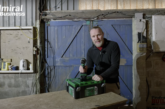I am starting to work my way through impact drivers, testing each one against the competition to see what they offer and, early next year, we will have a round-up of features and benefits of each make and model.
You might imagine that the only thing you can really compare with impact drivers is the speed and torque, but as I tested them I found a lot more to talk about.
Having said that most people who are working off a particular battery platform are going to buy an impact driver that fits those batteries but, when you start looking around, you will find that power tool manufacturers are now packaging impact drivers and combi-drills into a boxed set (or maybe a bag) to woo you away from your current brand.
For more articles on Makita click here. For more from Roger Bisby click here.
So, to illustrate that there are differences, I kick off with two machines I consider to be high flyers – the Makita DTD 170 and the DTS 141.
The Makita DTD 170 gives a max torque of 175 Nm and has six different functions on an electronic sequencing switch. There are four speeds and the ‘T’ mode, which spins fast to drive a self-drilling Tek Screw through the sheet steel, and then slows to tighten, making sure that the thread is not stripped as it bites into the host material.
The other mode is the A assist, which is a slow start. This helps stop the screw skidding around on metal. It also helps prevent cam out and cross threading, but I find it is also perfect for those light jobs, such as fixing door furniture, that need a screwdriver rather than an impact driver.
You could argue that with all these settings and computer chip control there is more to go wrong, but Makita makes a lot of very reliable power tools and we hope this is among them.
Certainly the brushless motor has proved a big success in their drill drivers and gives you a very long run time. Most people can work all day on the 5.0Ah battery. If you want to drive in bolts or tighten nuts, Makita rates this machine to M14 but with the battery and motor protection there is no real risk of overload. I find a dab of grease on the thread means you can really tighten M14 to 170Nm. Getting them undone is another matter. I have yet to come across an impact driver that undoes what it can do up.
If you are looking for a quieter life then the DTS 141 is for you. The oil-pulse driver squirts high pressure oil into a cavity and drives the driver round, not so much by impact as a longer push action. This completely eliminates the hammer and anvil and the noise that goes with it.
That is not to say it is silent but that top-end harsh noise that damages the ear drums and drives everyone in the building nuts is gone. The downside is that you’ve lost some impact power and speed, so the torque is down to around 40Nm.
Before you throw your hands in the air (too late)![]() you need to ask yourself one question: “Do you really need the most powerful impact driver in the world? Well do you?”
you need to ask yourself one question: “Do you really need the most powerful impact driver in the world? Well do you?”
For most jobs the 40Nm is plenty, and it was only a few years ago that the average impact driver was around this figure, so why are we chasing ever higher torque?
The fact that more powerful impact drivers come with different settings suggest that too much power can be a bad thing because you start trashing bits and screw heads.
Those higher torque settings are really only applicable on hex heads and bolts where cam out isn’t an issue. This machine still gives you a brushless motor, three speeds and the Tek setting, so there is a great deal of control there.
The bottom line is that with these two machines you have a choice. For me the quieter, softer, oil-driven technology is where I would rather be, and I look forward to the day when the now constant machine gun rattle of impact drivers all around the site is an exception.
![]()
This article first appeared in Professional Builder magazine November 2017, a free monthly magazine available on all good trade counters across the UK.
To receive our bi-weekly e-newsletter with the latest competitions, tool reviews and industry news, fill out the form below.








